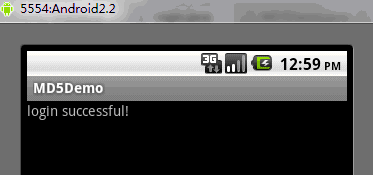package
com.loulijun.md5demo;
import
java.security.MessageDigest;
import
android.app.Activity;
import
android.content.Intent;
import
android.content.SharedPreferences;
import
android.os.Bundle;
import
android.view.View;
import
android.widget.Button;
import
android.widget.EditText;
import
android.widget.Toast;
public
class
MD5Demo
extends
Activity {
private
EditText username, password;
private
Button savebtn, loginbtn;
String user, pass;
@Override
public
void
onCreate(Bundle savedInstanceState) {
super
.onCreate(savedInstanceState);
setContentView(R.layout.main);
username = (EditText) findViewById(R.id.username);
password = (EditText) findViewById(R.id.password);
savebtn = (Button) findViewById(R.id.save);
loginbtn = (Button) findViewById(R.id.login);
savebtn.setOnClickListener(
new
Button.OnClickListener() {
@Override
public
void
onClick(View v) {
SharedPreferences pre = getSharedPreferences(
"loginvalue"
,
MODE_WORLD_WRITEABLE);
pass = MD5(password.getText().toString());
user = username.getText().toString();
if
(!pass.equals(
""
) && !user.equals(
""
)) {
pre.edit()
.putString(
"username"
,
username.getText().toString())
.putString(
"password"
, encryptmd5(pass)).commit();
Toast.makeText(getApplicationContext(),
"保存成功!"
,
Toast.LENGTH_SHORT).show();
}
else
{
Toast.makeText(getApplicationContext(),
"密码不能为空!"
,
Toast.LENGTH_LONG).show();
}
}
});
loginbtn.setOnClickListener(
new
Button.OnClickListener() {
@Override
public
void
onClick(View v) {
SharedPreferences sp = getSharedPreferences(
"loginvalue"
,
MODE_WORLD_READABLE);
String loginuser = sp.getString(
"username"
,
null
);
String loginpass = sp.getString(
"password"
,
null
);
user = username.getText().toString();
pass = password.getText().toString();
String passmd5 = MD5(pass);
String encryptmd5 = encryptmd5(passmd5);
System.out.println(
"username="
+ loginuser
+
"-------------password="
+ loginpass);
System.out.println(
"user=="
+ user
+
"-------------encryptmd5=="
+ encryptmd5);
if
(!user.equals(
""
) && !pass.equals(
""
)) {
if
(user.equals(loginuser) && encryptmd5.equals(loginpass)) {
Intent intent =
new
Intent();
intent.setClass(MD5Demo.
this
, Login.
class
);
MD5Demo.
this
.startActivity(intent);
finish();
}
else
{
Toast.makeText(getApplicationContext(),
"密码是错误的!"
,
Toast.LENGTH_LONG).show();
}
}
else
{
Toast.makeText(getApplicationContext(),
"密码不能为空!"
,
Toast.LENGTH_LONG).show();
}
}
});
}
public
static
String MD5(String str) {
MessageDigest md5 =
null
;
try
{
md5 = MessageDigest.getInstance(
"MD5"
);
}
catch
(Exception e) {
e.printStackTrace();
return
""
;
}
char
[] charArray = str.toCharArray();
byte
[] byteArray =
new
byte
[charArray.length];
for
(
int
i =
0
; i < charArray.length; i++) {
byteArray[i] = (
byte
) charArray[i];
}
byte
[] md5Bytes = md5.digest(byteArray);
StringBuffer hexValue =
new
StringBuffer();
for
(
int
i =
0
; i < md5Bytes.length; i++) {
int
val = ((
int
) md5Bytes[i]) &
0xff
;
if
(val <
16
) {
hexValue.append(
"0"
);
}
hexValue.append(Integer.toHexString(val));
}
return
hexValue.toString();
}
public
static
String encryptmd5(String str) {
char
[] a = str.toCharArray();
for
(
int
i =
0
; i < a.length; i++) {
a[i] = (
char
) (a[i] ^
'l'
);
}
String s =
new
String(a);
return
s;
}
}


